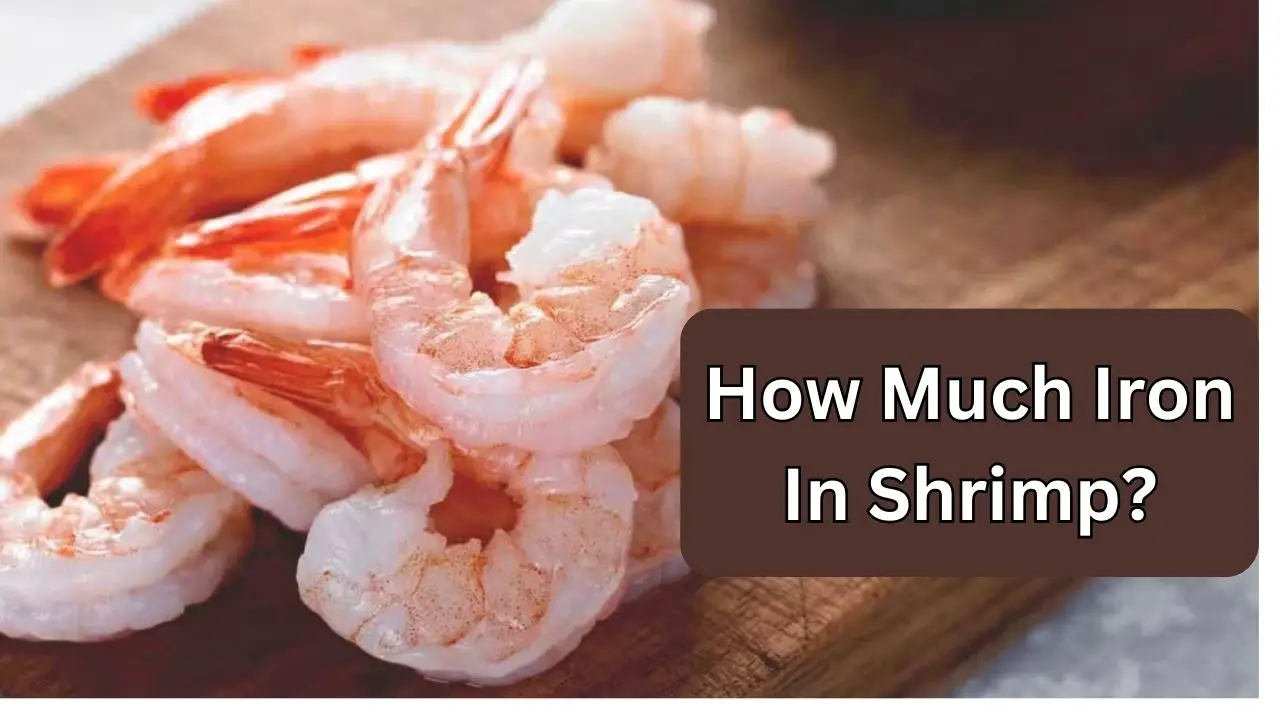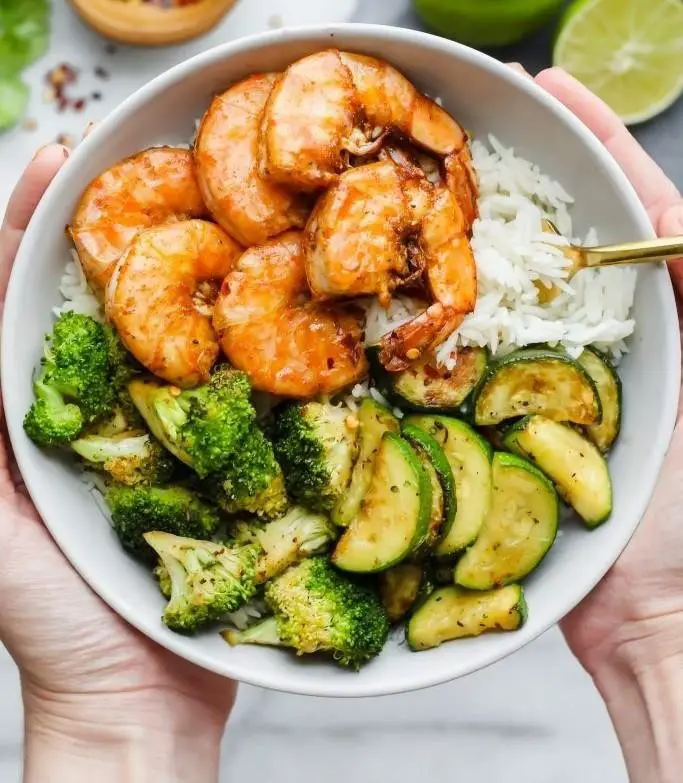How Much Iron In Shrimp: A Detailed Nutritional Guide

Shrimp is a seafood delight enjoyed by countless people around the world. These small, flavorful creatures are an everyday favorite on dinner plates and in various cuisines, offering many nutritional benefits.
So, how much iron is in shrimp?
Shrimp usually contains approximately 0.433 milligrams of iron in a 3-ounce serving. However, the amount of iron can vary significantly, ranging from 0.26 milligrams to 5.32 milligrams per 100 grams, depending on factors like the cooking method and the specific type of shrimp consumed.
This article will explore the nutritional value of shrimp and how they can contribute to your iron intake; let’s dive right in.
How Much Iron In Shrimp?
Shrimp is a valuable addition to one’s diet due to its noteworthy iron content. Iron can vary depending on factors such as the type of shrimp and how it’s prepared.
Are shrimp high in iron? Well, despite its small size, shrimp does contain iron. A 3-ounce (85-gram) serving of shrimp provides approximately 0.433 milligrams of iron.
On average, canned mixed-species shrimp typically contain around 2.13 milligrams (mg) of iron per every 100 grams. It’s important to note that the actual iron content can vary depending on factors such as cooking method and shrimp type, ranging from approximately 0.26 mg to 5.32 mg per every 100 grams.
Types of Shrimp With Their Iron Content
Here’s a table of the iron content (in milligrams) per 100g portion for different shrimp preparations and related foods:
| Shrimp | Iron (Fe) Content |
| Crustaceans, shrimp, cooked | 0.51 mg |
| Shrimp, baked or broiled | 0.27 mg |
| Shrimp, steamed or boiled | 0.26 mg |
| Shrimp, fried | 1.05 mg |
| Shrimp salad | 1.17 mg |
| Shrimp, grilled | 0.27 mg |
| Shrimp, canned | 2.13 mg |
| Shrimp, dried | 5.32 mg |
| Soup, cream of shrimp, canned, condensed | 0.42 mg |
| Crustaceans, shrimp, raw | 0.52 mg |
| Snacks, shrimp cracker | 1.91 mg |
| APPLEBEE’S, Double Crunch Shrimp | 1.03 mg |
| T.G.I. FRIDAY’S, FRIDAY’S Shrimp, breaded | 0.53 mg |
| DENNY’S, golden fried shrimp | 1.54 mg |
| CRACKER BARREL, country fried shrimp platter | 1.53 mg |
| Restaurant, Chinese, shrimp and vegetables | 0.72 mg |
| Restaurant, family style, shrimp, breaded and fried | 1.16 mg |
| Crustaceans, shrimp, mixed species, canned | 2.13 mg |
| Fast foods, shrimp, breaded and fried | 0.86 mg |
| Crustaceans, shrimp, mixed species, cooked, breaded and fried | 1.26 mg |
Please note that these values are approximate and can vary based on factors like cooking methods and specific ingredients used in recipes.
Meeting Your Iron Requirements With Shrimp
Incorporating shrimp into one’s diet can assist in meeting daily iron requirements, especially for individuals facing challenges in obtaining sufficient iron from other sources.
Remembering that a well-rounded dietary regimen encompasses various food groups is essential. This ensures that you obtain a wide array of essential nutrients. Combining shrimp with iron-enhancing foods like vitamin C-rich citrus fruits can further boost iron absorption.
Nutritional Profile Of Shrimp
In addition to iron, shrimp is a nutrient-packed seafood option. Here’s a breakdown of the nutrients you can find in a 3-ounce serving of shrimp:
| Nutrient | Amount per 3-ounce serving |
| Calories | 84.2 |
| Protein | 20.4 grams |
| Phosphorus | 201 mg |
| Potassium | 220 mg |
| Zinc | 1.39 mg |
| Iron | 0.433 mg |
| Magnesium | 33.2 mg |
| Sodium | 94.4 mg |
Shrimp is renowned for its abundant iodine content, a crucial mineral essential for supporting thyroid function and enhancing brain health.
Furthermore, it boasts a wealth of omega-3 fatty acids, known for their myriad advantages for both heart and brain well-being.
The Role of Iron In The Body
Iron is an essential mineral that plays a crucial role in the human body. Its primary duty involves transporting oxygen through the bloodstream as part of red blood cells.
When there is an iron deficiency, the body struggles to produce sufficient healthy red blood cells, resulting in anemia. Anemia manifests through symptoms like fatigue, weakness, and compromised immune function.
Recommended Daily Intake Of Iron
The daily iron requirement varies based on factors such as age, gender, and life stage. For non-pregnant adults, the recommended intake typically ranges from 8 to 18 milligrams (mg) per day.
It is crucial to consume adequate iron to replenish the natural daily losses in the body.
| Life Stage | Recommended Amount |
| Birth to 6 months | 0.27 mg |
| Infants 7–12 months | 11 mg |
| Children 1–3 years | 7 mg |
| Children 4–8 years | 10 mg |
| Children 9–13 years | 8 mg |
| Teen boys 14–18 years | 11 mg |
| Teen girls 14–18 years | 15 mg |
| Adult men 19–50 years | 8 mg |
| Adult women 19–50 years | 18 mg |
| Adults 51 years and older | 8 mg |
| Pregnant teens | 27 mg |
| Pregnant women | 27 mg |
| Breastfeeding teens | 10 mg |
| Breastfeeding women | 9 mg |
Iron Absorption and Storage
Interestingly, the amount of iron the body absorbs can vary depending on its existing stores. When iron stores are low, the body tends to increase its absorption of iron from the consumed food.
Conversely, if your iron stores are sufficient, your body absorbs less dietary iron to avoid overload. This finely tuned regulation helps maintain iron balance in the body.
Is Shrimp High In Cholesterol?
One concern often associated with shrimp is its cholesterol content. A 3-ounce serving of shrimp contains 161 milligrams of cholesterol.
While it might appear counterintuitive, scientific research suggests that dietary cholesterol obtained from sources such as shrimp may not have a substantial impact on the cholesterol levels in most individuals.
The body’s synthesis of cholesterol is influenced by the intake of dietary sources, and the consumption of foods abundant in omega-3 fatty acids, like shrimp, could potentially offset any potential negative effects.
Antioxidants In Shrimp
Shrimp is also known for containing a vital antioxidant called astaxanthin. This compound is the reason behind the reddish color of shrimp cells.
Research has shown that astaxanthin may have potential benefits in protecting against inflammation and reducing the risk of chronic diseases like heart disease and neurodegenerative conditions such as Alzheimer’s disease.
Concerns About Farm-Raised Shrimp
A noteworthy consideration is the source of shrimp. A significant portion of shrimp consumed in the United States is imported from other countries, often as farm-raised shrimp. Certain farms may employ antibiotics to combat common shrimp farming diseases.
Although there haven’t been any significant adverse health effects linked to antibiotic use in shrimp, it raises concerns about antibiotic resistance and the potential introduction of antibiotic-contaminated shrimp into our food supply.
Shrimp Allergies
Shellfish, including shrimp, can trigger allergies in some individuals. The proteins found in shrimp, particularly tropomyosin, can cause allergic reactions.
These reactions can range from mild symptoms like skin rashes to more severe and potentially life-threatening anaphylaxis. Individuals with shrimp allergies must exercise caution and avoid direct or indirect exposure to shrimp.
Choosing High-Quality Shrimp
To enjoy the benefits of shrimp while minimizing potential risks, it’s crucial to select high-quality shrimp. When purchasing shrimp, look for firm, translucent shells with no blackened edges or spots.
They should have a mild, ocean-like scent. Buying from reputable suppliers who can provide information about the shrimp’s origin and handling practices is advisable.

Source: Pinterest
How Much Shrimp Can I Eat In A Day?
The recommended daily intake of shrimp can vary depending on factors like age and specific circumstances:
- Children between the ages of 1 and 3 can safely enjoy consuming three medium-sized shrimp or approximately an ounce’s worth daily.
- Children between the ages of 4 and 7 may consume approximately 2 ounces, equivalent to six medium-sized shrimp, on a daily basis.
- Adults have a typical consumption guideline for shellfish or shrimp, suggesting they can enjoy up to three servings per week. This recommendation ensures a balanced intake.
- Pregnant and lactating women can incorporate shrimp into their diet safely, consuming up to 4 ounces per serving. It’s advisable to enjoy this nutritious seafood option 2-3 times a week, as shrimp have low mercury levels and offer essential nutrients crucial for the well-being and development of both the mother and the baby.
Note: Please ensure that shrimp is adequately cooked to prevent food-borne illness. Also, be aware of the source of the shrimp for safety reasons and avoid eating raw shrimp found in sushi or sashimi.
Frequently Asked Questions (FAQs)
How Much Iron Is In Prawn?
The iron content in prawns can vary based on their specific type and preparation methods. On average, a three-ounce serving of prawns typically contains approximately 3 milligrams of iron. This amount corresponds to roughly 18% of the recommended daily intake for iron in a typical diet.
Is Shrimp Good For Weight Loss?
Shrimp can benefit weight loss when prepared without excessive oil and consumed in recommended portions. It’s low in calories, carbs, and fat while providing essential nutrients, making it a healthy choice for weight-conscious individuals.
How Much Iron Is In Beef?
The iron content in beef varies depending on factors like cut and preparation. On average, a 100-gram serving of cooked beef provides around 2.1 to 2.7 milligrams of iron, making it a good source of this essential mineral.
Conclusion
In conclusion, regarding how much iron is in shrimp, it can be a valuable addition to your diet for its iron content.
While the iron levels may vary depending on factors like preparation and type, shrimp offers a modest but beneficial source of this essential mineral.





